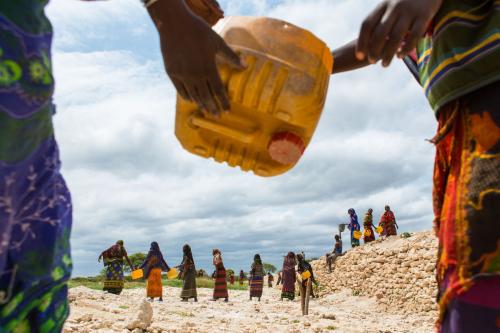As world leaders convene for this year’s U.N. General Assembly, sexual and reproductive health and rights (SRHR) are set to be a key agenda item. This year marks the 30th anniversary of the U.N.’s landmark International Conference on Population and Development (ICPD), where universal access to SRHR was first recognized as a global priority. It was later incorporated into the Sustainable Development Goals (SDGs 3.7 and 5.6) in 2015.
Ensuring sexual and reproductive health and rights for people around the world remains an urgent priority. In the U.S., debates over reproductive rights and justice—including abortion access, assisted reproductive technologies (ARTs), and racial disparities in healthcare—are mobilizing grassroots movements, fueling legal battles, and are expected to influence electoral outcomes this November. However, the debate extends far beyond the U.S., reflecting a global moment where both old and new SRHR challenges are being renegotiated at national and international levels.
As the global community reflects on the past three decades, a key question remains: How can we ensure the unfinished work of universal SRHR while navigating the growing complexities of today’s political and demographic landscape?
The “Cairo Consensus,” thirty years on
Over the past year, the United Nations Population Fund (UNFPA) has undertaken a comprehensive review of progress made since the 1994 ICPD in Cairo, Egypt. The UNFPA review focuses on both the conference’s legacy and emerging challenges, culminating in a Global Synthesis Report to be presented at this year’s Summit of the Future. The ICPD was a historic gathering of more than 11,000 national and civil society representatives, resulting from decades of advocacy and evidence-based research. The conference marked a significant shift from a population control narrative to a people-centered approach toward development, affirming sexual and reproductive health, along with reproductive rights, as fundamental human rights.
The ICPD’s Programme of Action (often dubbed the “Cairo Consensus”) emphasized how intersections between education, health, and gender equality could not be isolated from broader questions of population and development. It included more than 200 recommendations that have shaped a wide range of national policies, programs, and service delivery models over the past three decades. Although progress has varied by indicator and region, two key areas have been cited as global success stories:
- Access to family planning: Over the last 30 years, the percentage of women aged 15-49 using modern contraceptive methods has increased worldwide, with Sub-Saharan Africa seeing the largest improvements.
- Reducing maternal mortality: From 2000 to 2020, global maternal mortality rates decreased by nearly 34% per 100,000 births. This reduction has likely been driven by strengthened healthcare service delivery and the decrease in unintended pregnancies through safer access to abortion.
The ICPD’s unfinished business
While significant—and sustained—progress has been made in SRHR, existing and emerging challenges persist. As the U.N.’s international community convenes, it will confront the ICPD’s “unfinished business” of ensuring universal access to SRHR.
- Universal SRHR: While indicators such as family planning access and maternal mortality show global improvements, the goal of achieving universal access to SRHR is far from complete. Many health, education, and political systems still discourage SRHR information and services, with unmet needs likely to worsen in humanitarian and climate crises. Even in areas of progress, such as maternal mortality, aggregate data often hides disparities between countries and communities. For example, Sub-Saharan Africa accounts for roughly 70% of global maternal deaths, highlighting the need for stronger obstetric care and addressing socioeconomic determinants of health in the region. Even within the same country or region, data shows how racial and socioeconomic health inequities impact SRHR outcomes. In the U.S., CDC data reveals that Black women face a significantly higher risk of dying from preventable pregnancy complications than white women.
- The politics of SRHR: The U.N.’s vision of SRHR, grounded in principles of bodily autonomy and reproductive choice, has long been shaped by political and power dynamics at local, national, and global levels. At the 1994 ICPD, key issues like the recognition of sexual rights and safe abortion remained divisive. The Programme of Action was a consensus document—some argued it went too far, others said it did too little. These tensions reflect long-standing debates within reproductive politics that persist to this day. We now find ourselves in a politically charged climate, where norms, laws, and policies around gender, sexuality, and reproductive freedoms are being contested in new and complex ways worldwide.
Achieving the SDGs’ vision of universal access to SRHR requires substantial political will and commitment at both national and international levels. While 80 countries reaffirmed their support for the 1994 ICPD agenda during its 30th anniversary at the U.N. General Assembly earlier this year, this is a decline from the original 179 signatories to the Programme of Action. Such weakened support highlights the fragile and shifting consensus around the ICPD, along with the need for renewed efforts to solidify lasting political commitments for the U.N.’s Agenda 2030.
- Diverse demographic futures: There is growing recognition that anxieties over “overpopulation” or “underpopulation” have historically stemmed from deeper structural issues such as economic inequality, racism, climate disasters, and pandemics. While many international population conferences before the ICPD targeted “overpopulation” in the Global South, shifting population patterns, along with norms in the global order, have now brought attention to demographic diversity Given this diversity, SRHR policies would likely be more effective if they accounted for each country’s specific demographic context. For example, eldercare should be a top priority within SRHR policies in areas with aging populations. However, a commitment to people-centered development and reproductive freedoms should remain at the heart of these policies. Demographic anxieties should not only be addressed with “demographic solutions”—such as pro-natalist policies incentivizing higher birth rates through monetary or other rewards—as this could lead to consequential backsliding in the decades-long global fight against population control.
Looking forward
As the U.N. community debates its commitment to the core principles of sexual and reproductive health and rights (SRHR) agenda, several key priorities remain at the forefront. Addressing inequalities in SRHR—particularly where race, disability, gender identity, and socioeconomic factors intersect—is essential for advancing reproductive freedom and for centering a justice-based approach within what has often been critiqued as a solely rights-based framework. On the other hand, achieving universal SRHR requires sustained political will, grounded in clear legal and policy commitments and robust financing, along with collaboration between governments and civil society – which is exactly what led to the forging of the “Cairo Consensus” thirty years ago. Moving forward, people-centered policies that adapt to diverse sociopolitical realities can guide global leaders toward truly realizing the SDG’s vision of universal SRHR.




Commentary
Reaffirming the UN’s commitment to global reproductive rights
September 19, 2024